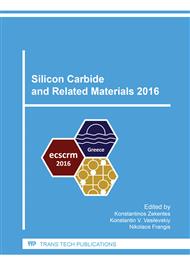p.147
p.151
p.155
p.159
p.163
p.167
p.173
p.177
p.181
Electrical Properties and Interface Structure of SiC MOSFETs with Barium Interface Passivation
Abstract:
A Barium-rich interface process provides SiO2/SiC interface conditions suitable for obtaining SiC field-effect (FE) channel mobility twice that of a nitric oxide (NO) passivation anneal. The temperature dependence of the field-effect mobility indicates clear differences in their interface properties. Secondary-ion mass spectrometry (SIMS) indicates that Ba remains predominantly at the SiO2/SiC interface, with only ~1×1017 cm-3 Ba in the oxide.The interface structure and chemistry of the Ba-modified MOS devices was investigated using scanning transmission electron microscopy (STEM) and energy-dispersive X-ray spectroscopy (EDS). High-angle annular dark-field (HAADF) imaging reveals that the Ba interface layer results in an oxide-interface region not present in the NO annealed control sample. EDS mapping shows that this is a Ba-rich oxide interface layer. Using a new technique “revolving STEM” (RevSTEM) to correct drift and image distortion, SiC strain maps were generated. With an NO anneal there is tensile strain within SiC at the SiO2/SiC interface, along the C-axis direction. With the Ba interlayer, however, there is no observable strain relative to the bulk SiC. This interface strain may correlate with the inversion layer mobility, with an unstrained interface preferred.
Info:
Periodical:
Pages:
163-166
Citation:
Online since:
May 2017
Keywords:
Price:
Сopyright:
© 2017 Trans Tech Publications Ltd. All Rights Reserved
Share:
Citation:


